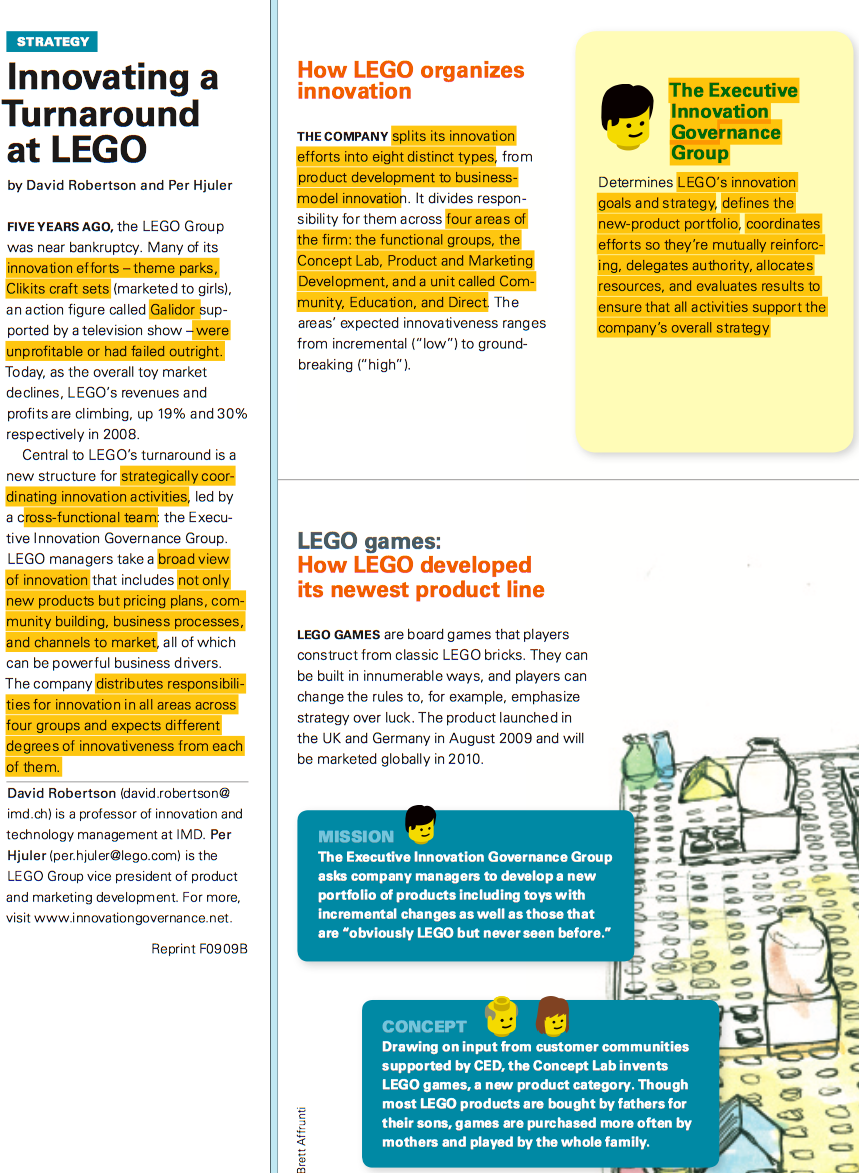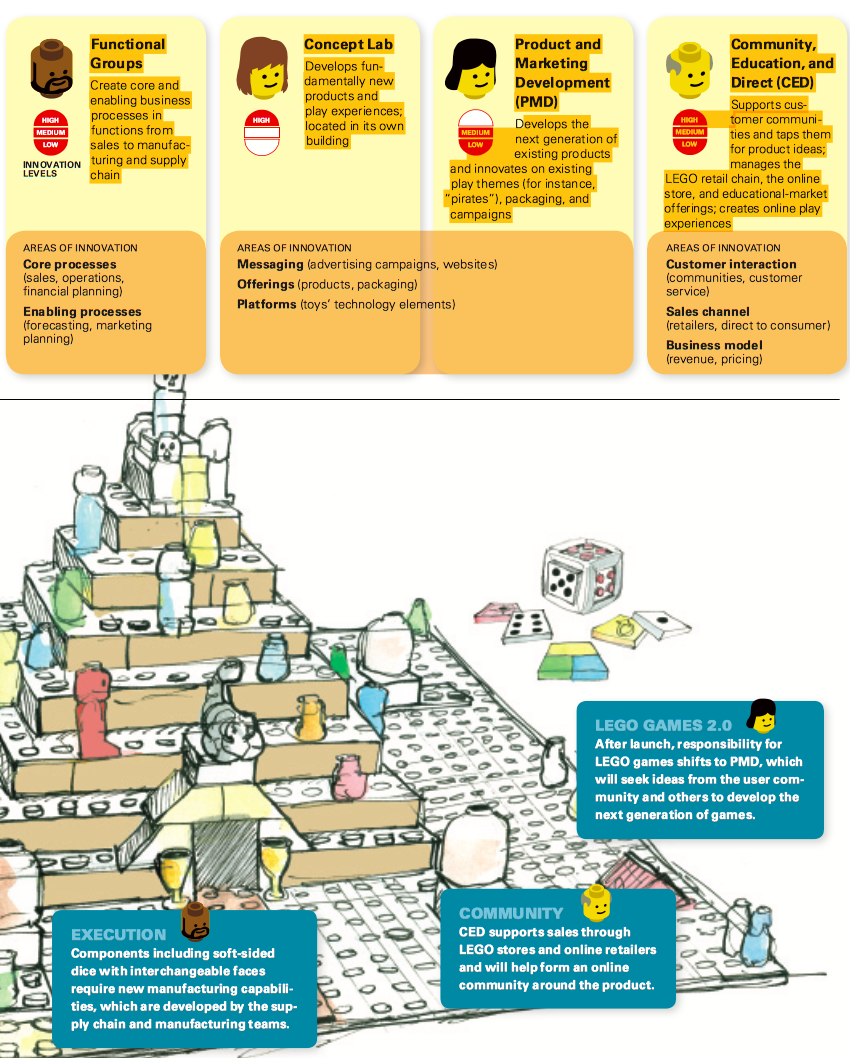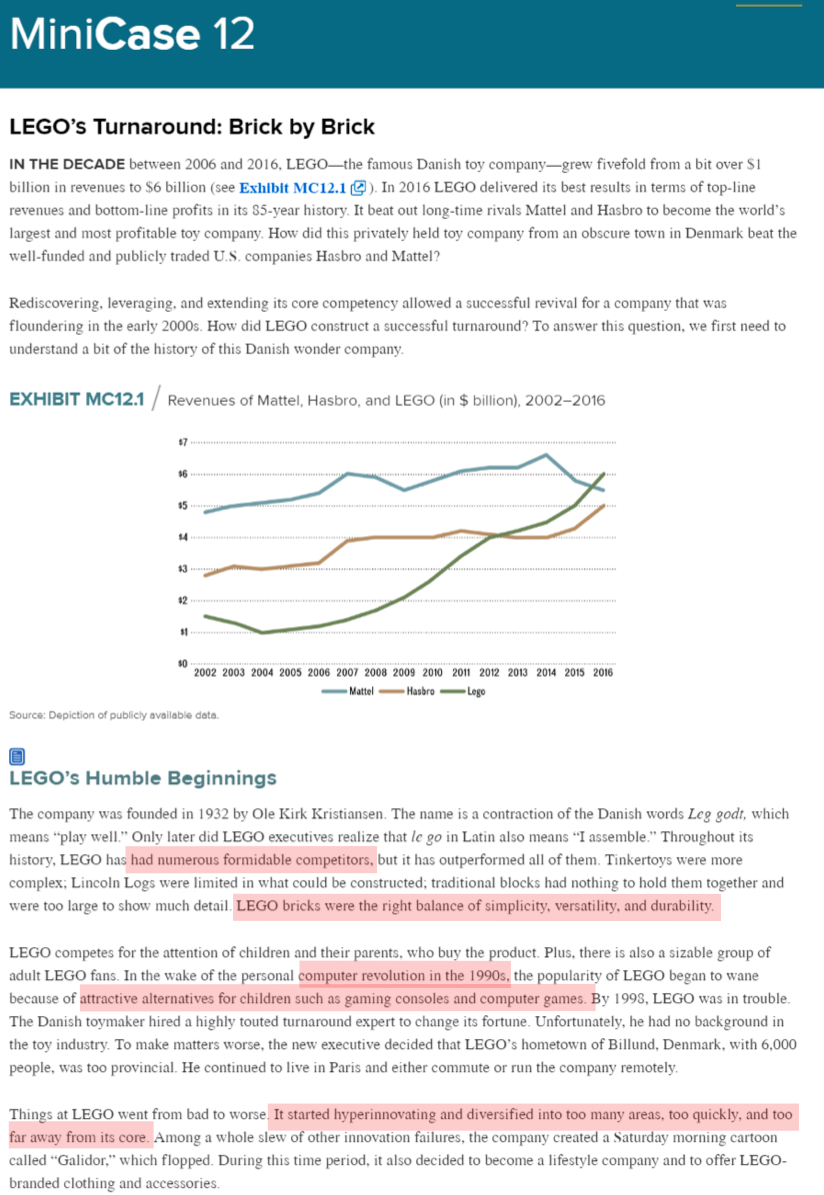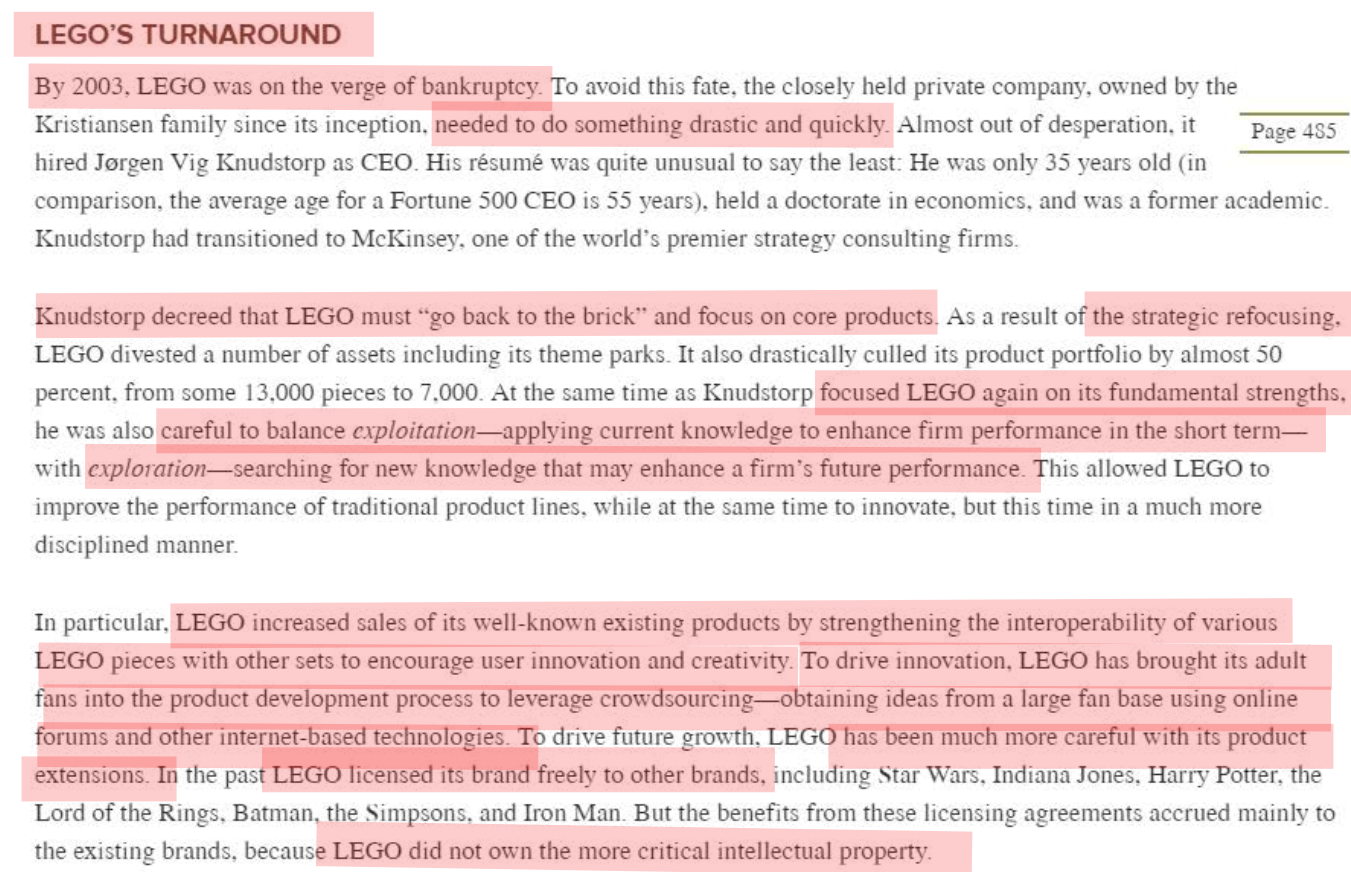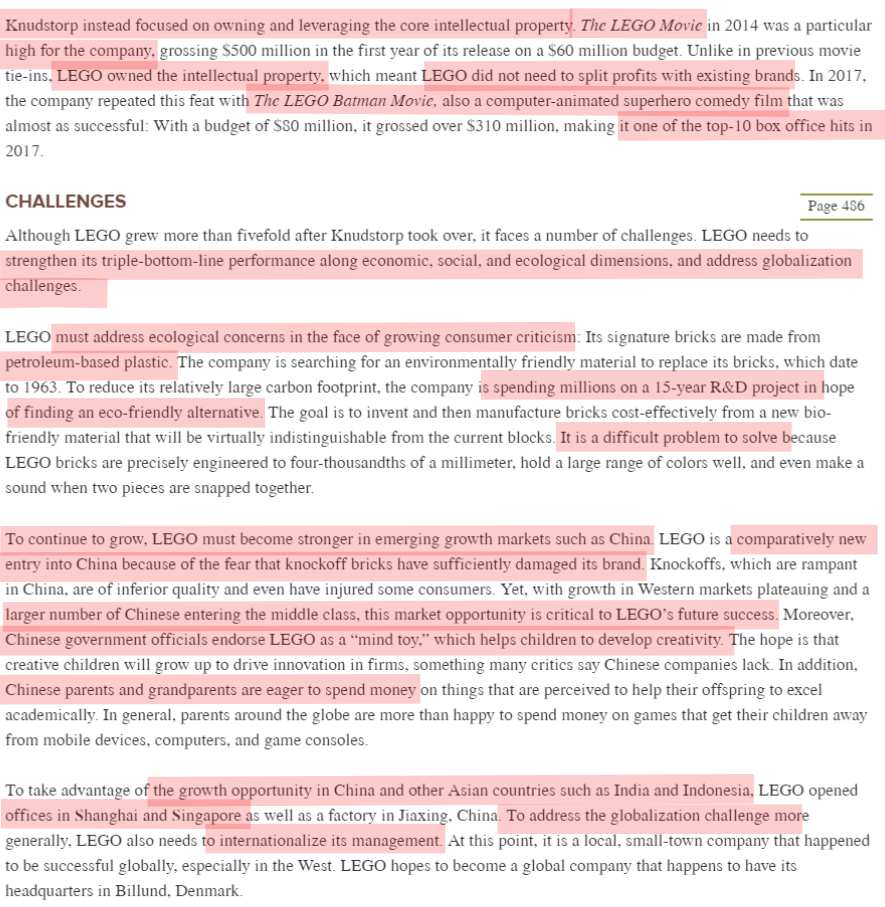I have to answer the following question and do not how to start. I need detailed ideas please.
How would you analyze and assess business and corporate level strategy of LEGO, with a focus on its core competencies? Based on analysis and assessment, please provide your outlook of LEGO and what you think LEGO should to do sustain its competitive advantage in the future. Please be specific and be sure to explain!
Sources to consult when answering the question are these 5 images of which:
- First 2 images arefrom the case "Innovating a Turnaround at LEGO"
- 3 next images is a MiniCase - LEGO's Turnaround
Each case provides information on how LEGO was able to turn itself around and how it fared afterwards. In addition, second case also demonstrates some of the challenges LEGO is facing after more than a decade of outstanding growth.
I should base my answer on LEGO's strategy, core competencies, and its challenges ahead from the cases provided.
Thank you in advance for your time and help :)
STRATEGY Innovating a How LEGO organizes Turnaround innovation The Executive Innovation at LEGO THE COMPANY splits its innovation Governance efforts into eight distinct types, from Group by David Robertson and Per Hjuler product development to business- Determines LEGO's innovation model innovation. It divides respon goals and strategy, defines the FIVE YEARS AGO, the LEGO Group sibility for them across four areas of the firm: the functional groups, the new-product portfolio, coordinates was near bankruptcy. Many of its efforts so they're mutually reinforce innovation efforts - theme parks, Concept Lab, Product and Marketing Development, and a unit called Com- ing, delegates authority, allocates Clikits craft sets (marketed to girls), munity, Education, and Direct. The resources, and evaluates results to an action figure called Galidor sup- are as' expected innovativeness ranges ensure that all activities support the ported by a television show - were unprofitable or had failed outright. from incremental ("low") to ground- company's overall strategy Today, as the overall toy market breaking ("high" ). declines, LEGO's revenues and profits are climbing, up 19% and 30% respectively in 2008. Central to LEGO's turnaround is a new structure for strategically coor- dinating innovation activities, led by a cross-functional team: the Execu- tive Innovation Governance Group. LEGO managers take a broad view LEGO games: of innovation that includes not only How LEGO developed new products but pricing plans, com- its newest product line munity building, business processes, and channels to market, all of which LEGO GAMES are board games that players can be powerful business drivers. construct from classic LEGO bricks. They can The company distributes responsibili be built in innumerable ways, and players can ties for innovation in all areas across change the rules to, for example, emphasize four groups and expects different strategy over luck. The product launched in degrees of innovativeness from each the UK and Germany in August 2009 and will of them. be marketed globally in 2010. David Robertson (david.robertson@ imd.ch) is a professor of innovation and technology management at IMD. Per MISSION Hjuler (per.hjuler@lego.com) is the The Executive Innovation Governance Group LEGO Group vice president of product asks company managers to develop a new and marketing development. For more, portfolio of products including toys with visit www.innovationgovernance.net. incremental changes as well as those that Reprint F0909B are "obviously LEGO but never seen before." CONCEPT Drawing on input from customer communities supported by CED, the Concept Lab invents LEGO games, a new product category. Though rett Affrunti most LEGO products are bought by fathers for their sons, games are purchased more often by mothers and played by the whole family.Functional Concept Lab Product and Community, Groups Develops fun- Marketing Education, and Create core and damentally new Development Direct (CED) enabling business products and play experiences; (PMD Supports cus- processes in HIGH tomer communi- MEDIUM functions from located in its own MEDIUM Develops the next generation of MEDIUM building LOW LOW ties and taps them LOW sales to manufact existing products or product ideas; INNOVATION turing and supply LEVELS chain and innovates on existing manages the play themes (for instance, LEGO retail chain, the online "pirates"), packaging, and store, and educational-market campaigns offerings; creates online play experiences AREAS OF INNOVATION AREAS OF INNOVATION AREAS OF INNOVATION Core processes Messaging (advertising campaigns, websites) Customer interaction (sales, operations, Offerings (products, packaging (communities, customer financial planning) service) Enabling processes Platforms (toys' technology elements) Sales channel forecasting, marketing (retailers, direct to consumer) planning) Business model revenue, pricing) SO LEGO GAMES 2.0 After launch, responsibility for LEGO games shifts to PMD, which will seek ideas from the user com- munity and others to develop the next generation of games. 0.0 0104 COMMUNITY EXECUTION CED supports sales through Components including soft-sided LEGO stores and online retailers dice with interchangeable faces and will help form an online require new manufacturing capabili community around the product. ties, which are developed by the sup- ply chain and manufacturing teams.MiniCase 12 LEGO's Turnaround: Brick by Brick IN THE DECADE between 2006 and 2016, LEGO-the famous Danish toy company-grew fivefold from a bit over $1 billion in revenues to $6 billion (see Exhibit MC12.1 (@). In 2016 LEGO delivered its best results in terms of top-line revenues and bottom-line profits in its $5-year history. It beat out long-time rivals Mattel and Hasbro to become the world's largest and most profitable toy company. How did this privately held toy company from an obscure town in Denmark beat the well-funded and publicly traded U.S. companies Hasbro and Mattel? Rediscovering, leveraging, and extending its core competency allowed a successful revival for a company that was floundering in the early 2000s. How did LEGO construct a successful turnaround? To answer this question, we first need to understand a bit of the history of this Danish wonder company. EXHIBIT MC12.1 / Revenues of Mattel, Hasbro, and LEGO (in $ billion), 2002-2016 2002 2003 2004 2005 2006 2007 2008 2009 2010 2011 2012 2013 2014 2015 2016 -Mattel Hasbro Lego Source: Depiction of publicly available data. LEGO's Humble Beginnings The company was founded in 1932 by Ole Kirk Kristiansen. The name is a contraction of the Danish words Leg godt, which means "play well." Only later did LEGO executives realize that le go in Latin also means "I assemble." Throughout its history, LEGO has had numerous formidable competitors, but it has outperformed all of them. Tinkertoys were more complex; Lincoln Logs were limited in what could be constructed; traditional blocks had nothing to hold them together and were too large to show much detail. LEGO bricks were the right balance of simplicity, versatility, and durability. LEGO competes for the attention of children and their parents, who buy the product. Plus, there is also a sizable group of adult LEGO fans. In the wake of the personal computer revolution in the 1990s, the popularity of LEGO began to wane because of attractive alternatives for children such as gaming consoles and computer games. By 1998, LEGO was in trouble. The Danish toymaker hired a highly touted turnaround expert to change its fortune. Unfortunately, he had no background in the toy industry. To make matters worse, the new executive decided that LEGO's hometown of Billund, Denmark, with 6,000 people, was too provincial. He continued to live in Paris and either commute or run the company remotely. Things at LEGO went from bad to worse. It started hyperinnovating and diversified into too many areas, too quickly, and too far away from its core. Among a whole slew of other innovation failures, the company created a Saturday morning cartoon called "Galidor," which flopped. During this time period, it also decided to become a lifestyle company and to offer LEGO- branded clothing and accessories.LEGO'S TURNAROUND By 2003, LEGO was on the verge of bankruptcy. To avoid this fate, the closely held private company, owned by the Kristiansen family since its inception, needed to do something drastic and quickly. Almost out of desperation. it Page 485 hired Jorgen Vig Knudstorp as CEO. His resume was quite unusual to say the least: He was only 35 years old (in comparison, the average age for a Fortune 500 CEO is 55 years), held a doctorate in economics, and was a former academic. Knudstorp had transitioned to Mckinsey, one of the world's premier strategy consulting firms. Knudstorp decreed that LEGO must "go back to the brick" and focus on core products. As a result of the strategic refocusing. LEGO divested a number of assets including its theme parks. It also drastically culled its product portfolio by almost 50 percent, from some 13,000 pieces to 7.000. At the same time as Knudstorp focused LEGO again on its fundamental strengths. he was also careful to balance exploitation-applying current knowledge to enhance firm performance in the short term- with exploration-searching for new knowledge that may enhance a firm's future performance. This allowed LEGO to improve the performance of traditional product lines. while at the same time to innovate, but this time in a much more disciplined manner. In particular, LEGO increased sales of its well-known existing products by strengthening the interoperability of various LEGO pieces with other sets to encourage user innovation and creativity. To drive innovation, LEGO has brought its adult fans into the product development process to leverage crowdsourcing-obtaining ideas from a large fan base using online forums and other internet-based technologies. To drive future growth. LEGO has been much more careful with its product extensions. In the past LEGO licensed its brand freely to other brands, including Star Wars, Indiana Jones, Harry Potter, the Lord of the Rings, Batman, the Simpsons. and Iron Man. But the benefits from these licensing agreements accrued mainly to the existing brands, because LEGO did not own the more critical intellectual property.Knudstorp instead focused on owning and leveraging the core intellectual property. The LEGO Movie in 2014 was a particular high for the company, grossing $500 million in the first year of its release on a $60 million budget. Unlike in previous movie tie-ins. LEGO owned the intellectual property, which meant LEGO did not need to split profits with existing brands. In 2017, the company repeated this feat with The LEGO Batman Movie, also a computer-animated superhero comedy film that was almost as successful: With a budget of $80 million, it grossed over $310 million, making it one of the top-10 box office hits in 2017. CHALLENGES Page 486 Although LEGO grew more than fivefold after Knudstorp took over, it faces a number of challenges. LEGO needs to strengthen its triple-bottom-line performance along economic, social, and ecological dimensions, and address globalization challenges. LEGO must address ecological concerns in the face of growing consumer criticism: Its signature bricks are made from petroleum-based plastic. The company is searching for an environmentally friendly material to replace its bricks, which date to 1963. To reduce its relatively large carbon footprint, the company is spending millions on a 15-year R&D project in hope of finding an eco-friendly alternative. The goal is to invent and then manufacture bricks cost-effectively from a new bio- friendly material that will be virtually indistinguishable from the current blocks. It is a difficult problem to solve because LEGO bricks are precisely engineered to four-thousandths of a millimeter, hold a large range of colors well, and even make a sound when two pieces are snapped together. To continue to grow, LEGO must become stronger in emerging growth markets such as China. LEGO is a comparatively new entry into China because of the fear that knockoff bricks have sufficiently damaged its brand. Knockoffs, which are rampant in China, are of inferior quality and even have injured some consumers. Yet, with growth in Western markets plateauing and a larger number of Chinese entering the middle class, this market opportunity is critical to LEGO's future success. Moreover, Chinese government officials endorse LEGO as a "mind toy," which helps children to develop creativity. The hope is that creative children will grow up to drive innovation in firms, something many critics say Chinese companies lack. In addition, Chinese parents and grandparents are eager to spend money on things that are perceived to help their offspring to excel academically. In general, parents around the globe are more than happy to spend money on games that get their children away from mobile devices, computers, and game consoles. To take advantage of the growth opportunity in China and other Asian countries such as India and Indonesia, LEGO opened offices in Shanghai and Singapore as well as a factory in Jiaxing, China. To address the globalization challenge more generally, LEGO also needs to internationalize its management. At this point, it is a local, small-town company that happened to be successful globally, especially in the West. LEGO hopes to become a global company that happens to have its headquarters in Billund, Denmark
